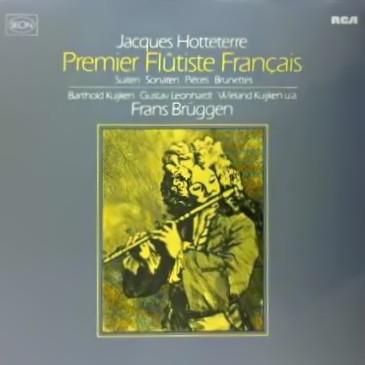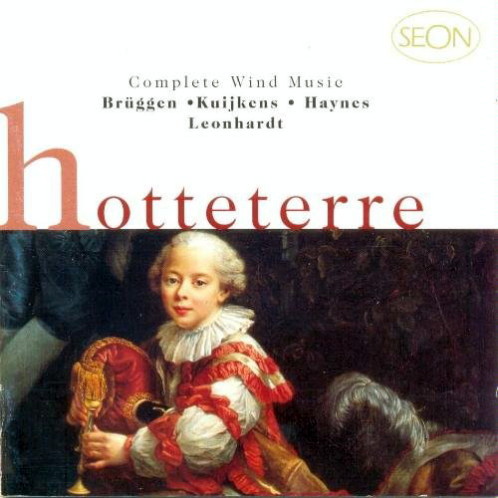 |
3 LPs
- 6776 002 - (p) 1977
|
 |
3 LPs -
RL 30425 - (p) 1980
|
 |
| 2 CDs -
SB2K 62942 - (c) 1997 |
|
PREMIER FLÛTISTE FRANÇAIS
|
|
|
|
|
|
|
|
| Jacques HOTTETERRE (c.1680-c.1761) |
|
|
|
|
|
|
|
| 1. |
Bourée
D'achille / Menuet - Méthode
pour la Musette, Œuvre X (1738) |
|
2' 21" |
A1 |
| 2. |
Suite
in B-flat Major for recorder and
continuo - Pieces pour la Flûte, Œuvre
II (1708) |
*
|
13' 35" |
A2-7
|
| 3. |
Ecos,
pour la flûte traversière seule - Pieces
pour la Flûte, Œuvre II (1708) |
*
|
2' 39" |
A8 |
| 4. |
Trio
Sonata in C Major for 2 oboes
and continuo - Sonates en Trio pour
les Flûtes, Traversières, etc., Œuvre
III (1712) |
|
5' 46" |
A9-12 |
| 5. |
Contredanse
"La Pharaone" - Méthode pour la
Musette, Œuvre X (1738) |
|
2' 38" |
B1 |
| 6. |
Trio
Sonata in D Minor for 2
recorders and continuo - Sonates en
Trio pour les Flûtes, Traversières,
etc., Œuvre III (1712) |
*
|
7' 11" |
B2-5 |
| 7. |
Suite
in D Major for German flute and
continuo - Premier Livre de Pièces
pour la Flûte-traversière, etc., Œuvre
II, Nouvelle Edition (1715) |
*
|
16' 41" |
B6-12 |
8.
|
Quitte
la musette - Marche des dragons - Air
- Méthode pour la Musette, Œuvre X
(1738) |
|
1' 55" |
C1 |
9.
|
Suite in E Minor for
German flute and continuo - Premier
Livre de Pièces pour la
Flûte-traversière, etc., Œuvre II,
Nouvelle Edition (1715) |
*
|
15' 37" |
C2-8 |
10.
|
Suite in C
Major for oboe and continuo - Deuxième
Livre de Pièces pour la
Flûte-traversière, etc., Œuvre V,
(1715) |
|
7' 38" |
C9-13 |
11.
|
Musette de Mr. Clerambault /
Menuet "La Badaut" - Méthode
pour la Musette, Œuvre X (1738)
|
|
1' 38" |
D1 |
12.
|
Suite
in E Minor for recorder and
continuo - Deuxième Livre de
Pièces pour la Flûte-traversière,
etc., Œuvre V, (1715)
|
|
16' 46" |
D2-8 |
13.
|
Fanfare et Les
Dieux for 3 German flutes
(Gai-Gravement) - Airs et
Brunettes a Deux et Trois Dessus
pour les Flûtes-traversières,
etc., Paris (undated)
|
|
2' 34" |
D9 |
14.
|
Prélude /
La Régencee - Tes Beaux Yeux
ma Nicole - Méthode pour la
Musette, Œuvre X (1738)
|
|
1' 40" |
E1 |
15.
|
Suite in G Major
for e German flutes - Deuxième
Suitte de pièces à deux Dessus
pour les Flûtes-traversières,
etc., Œuvre VI, (1717)
|
|
17' 40" |
E2-7 |
16.
|
Rigaudons
- Méthode pour la Musette, Œuvre X
(1738) |
|
1' 46" |
F1 |
17.
|
Prelude for
recorder - L'art de Préluder
sur la Flûtes-traversières,
etc., Œuvre VII, (1716)
|
|
1' 30" |
F2 |
18.
|
Prelude for
German flute - L'art de
Préluder sur la
Flûtes-traversières, etc.,
Œuvre VII, (1716)
|
|
1' 16" |
F3 |
19.
|
Prelude
for oboe - L'art de
Préluder sur la
Flûtes-traversières, etc.,
Œuvre VII, (1716)
|
|
1' 00" |
F4 |
20.
|
Prelude
for Soprano Viola da Gamba
- L'art de Préluder
sur la
Flûtes-traversières,
etc., Œuvre VII, (1716)
|
|
1' 32" |
F5 |
21.
|
Brunette "L'Autre jour
ma Cloris" (Tendrement) -
Airs et Brunettes a Deux et
Trois Dessus pour les
Flûtes-traversières, etc.,
Paris (undated)
|
|
6' 25" |
F6 |
| 22. |
Air de Mr Lambert
"Goûtons und doux repos"
(Tendrement) - Airs et
Brunettes a Deux et Trois
Dessus pour les
Flûtes-traversières, etc.,
Paris (undated)
|
|
3' 55" |
F7 |
|
|
|
|
|
|
1. |
2. |
3. |
4. |
5. |
6. |
7. |
8.
|
9. |
10. |
11. |
12. |
13. |
14. |
15. |
16. |
17. |
18. |
19. |
20. |
21. |
22. |
|
| Frans Brüggen,
Recorder, German flute |
|
* |
|
|
|
* |
|
|
|
|
|
* |
* |
|
* |
|
* |
|
|
|
|
|
|
| Barthold Kuijken,
German flute |
|
|
* |
|
|
|
* |
|
* |
|
|
|
* |
|
* |
|
|
* |
|
|
* |
* |
|
| Walter van Hauwe,
Recorder |
|
|
|
|
|
* |
|
|
|
|
|
|
|
|
|
|
|
|
|
|
|
|
|
| Oswald van
Olmen, German flute |
|
|
|
|
|
|
|
|
|
|
|
|
* |
|
|
|
|
|
|
|
|
|
|
| Bruces Haynes,
Oboe |
|
|
|
* |
|
|
|
|
|
* |
|
|
|
|
|
|
|
|
* |
|
|
|
|
| Ku Ebbinge,
Oboe |
|
|
|
* |
|
|
|
|
|
|
|
|
|
|
|
|
|
|
|
|
|
|
|
| Shelley
Gruskin, Musette |
* |
|
|
|
* |
|
|
* |
|
|
* |
|
|
* |
|
* |
|
|
|
|
|
|
|
| Danny Bond,
Bassoon |
|
|
|
* |
|
|
|
|
|
|
|
|
|
|
|
|
|
|
|
|
|
|
|
| Wieland
Kuijken, Viola da Gamba |
|
* |
|
|
|
* |
* |
|
* |
* |
|
* |
|
|
|
|
|
|
|
* |
|
* |
|
Toyohiko
Satoh, Lute
|
|
|
|
|
|
|
|
|
|
|
|
|
|
|
|
|
|
|
|
|
|
* |
|
Marianne
Kweksilber, Sopran
|
|
|
|
|
|
|
|
|
|
|
|
|
|
|
|
|
|
|
|
|
* |
* |
|
| Gustav
Leonhardt, Harpsichord |
|
* |
|
* |
|
* |
* |
|
* |
* |
|
* |
|
|
|
|
|
|
|
|
|
|
|
|
|
|
|
Luogo
e data di registrazione |
|
Doopsgezinde Kerk,
Haarlem (Holland) - Aprile &
Maggio 1976 *
Lutherse Kerk, Haarlem (Holland) -
Gennaio 1977
|
|
|
Registrazione: live
/ studio |
|
studio |
|
|
Producer /
Recording Supervisor |
|
Wolf Erichson
|
|
|
Recording Engineer
|
|
Dieter Thomsen
|
|
|
Prima Edizione LP |
|
Seon (Philips) | 6776
002 | 3 LPs - durata 50' 51" - 46'
08" - 36' 44" | (p) 1977 | ANA
Seon (RCA Red Seal) | RL 30425 | 3
LPs - durata 50' 51" - 46' 08" -
36' 44" | (p) 1980 | ANA
|
|
|
Edizione CD |
|
Sony | SB2K 62942 | 2
CDs - durata 69' 28" & 66' 27"
| (c) 1997 | ADD
|
|
|
Original Cover
|
|
Jacques Hotteterre le
Romain, nach einem kupferstich von
Bernard Picart (1673-1733),
Bibliothüque Nationale, Paris
|
|
|
Note |
|
-
|
|
|
|
|
All lovers of
the flute owe a debt of
gratitude to Jacques-Martin
Hotteterre (1674-1763), who
unquestionably did more than
any other player, composer
or instrument maker to
launch the transverse flute
as a viable alternative to
the traditional recorder.
Hotteterre not only wrote
the first instruction method
for modern flute ever
published (1707), but vvas
also, it seems, the High
Baroque era's first serious
composer for the instrument.
Born into a family of
instrument makers in the
provincial French
countryside, Hotteterre
apparently spent a good deal
of his early adulthood
studying music in Italy, for
he was popularly known as
"the Roman Hotteterre." His
first professional position
in France, around 1705, was
as a bassoonist, and a few
years later he became a flûte
de la chambre du roi
(flutist for the king's
chamber orchestra) at the
court of Louis XIV. He soon
began issuing flute suites,
suite-sonatas, trio sonatas
and duets that vastly
extended the instrument's
range and expression. Also
active as a flute teacher to
the nobility, he maintained
a busy workshop in which he
manufactured woodwinds of
all types, many of them
extravagantly decorated for
aristocratic amateurs. A
German visiting Paris in
1715, one Herr von
Uffenbach, described a visit
to Hotteterre’s
instrument-making atelier:
”M. Hotteterre... took me to
a gleaming chamber and there
showed me sundry beautiful
side-blown flutes.... He
went on to show me another
special instrument which he
himself had improved, a
musette, or kind of bagpipe,
which may be tuned to every
key, and which, happily, is
now in fashion here....
Together with another
musician at the keyboard he
played a sonata so
incomparably smooth and
pleasant, and with such
well-chosen embellishments,
that I couldn't hear and
admire him enough."
The present “biography in
sound” aims at representing
Hotteterre’s finest work for
a variety of woodwinds. Two
of the instruments heard
here, a musette and an oboe,
were made by Hotteterre
himself; the others are
copies of French instruments
from the early eighteenth
century. The program begins
with the sound of the
musette - whose rustic
strains, familiar to
Hotteterre during his
childhood, still seem
discernible behind his
courtly music for flute,
recorder and oboe.
Hotteterre is perhaps at his
best in exploiting those
plaintive, sighing,
languishing qualities of the
flute that writers of his
day singled out for comment.
Two examples are the
“dolorous" Sarabande
of the E-minor Suite (with
its dissonant harmonies and
expressive ornaments) and
the poignant Grave
of the C-major Trio Sonata
(marked by sighing rests,
syncopations and chromatic
bass). More animated are the
robust Gigue of the
C-major Suite-Sonata, vvith
its "hunting" motives, the
lively contrapuntal
sophistication of the
E-minor Suite's Prélude,
and the scintillating bursts
of notes found in parts of L’Art
de préluder. Even in
movements derived closely
from contemporary dance
forms, Hotteterre often
displays a noteworthy
originality, as in the Musette
of the G-major Duet Suite
(which has a minuet for a
trio section), or in his
increasingly elaborate
ornamentation of the same
suite's Sarabande.
Hotteterre’s works are also
important in being among the
first in France to include
elements of the Italian
style. His Suite-Sonatas of
1715 were, in fact, the
first sonatas for a melody
instrument and basso
continuo to be
published in France, mixed
in style though they still
are. Particularly Italianate
are his leaps and arpeggios,
most obviously in the Fugue
of his D-minor Trio Sonata
or the Prélude to
the same work, but also in
such otherwise typically
French dances as the D-
major Suite's Allemande.
Most significantly Italian,
perhaps, is the independence
of Hotteterre’s bass lines,
especially in the Allemande
of the E-minor Suite.
Jay
M. Balenkof
These
notes are based on those
by David Lasocki
and
Frans Brüggen which
accompanied the original
1977 release.
|
  |
|
|